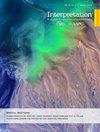Characteristics and Genesis of reef-bank complexes in deep shelf Facies: A Case Study of MiddleLate Jurassic in the Northern Amu Darya Basin, Central Asia
IF 1.1
4区 地球科学
Q3 GEOCHEMISTRY & GEOPHYSICS
Interpretation-A Journal of Subsurface Characterization
Pub Date : 2023-01-17
DOI:10.1190/int-2022-0055.1
引用次数: 0
Abstract
A large-rimmed carbonate platform was developed in the Amu Darya Basin during the middlelate Jurassic CallovianOxfordian period. What distinguishes it from typical carbonate platforms is that a series of reef-bank complexes were extensively developed in the deep shelf sedimentary zone of the basin. However, only a few studies have reported on the classification, characteristics, and genesis of these reef-bank complexes in relatively deep water, greatly limiting the development of deep-water carbonate sedimentology. To address this issue, the types and the genesis of reef-bank complexes in the deep shelf environment have been clarified based on the systematic petrography, seismic sedimentology, and geomorphology study of CallovianOxfordian carbonate rocks in the northern Amu Darya Basin during the middlelate Jurassic period. The results show that the reef-bank complexes are widely distributed in the deep shelf environment in the study area with laminar, reticulated, and zonal distributions. The reef-bank complexes include barrier-bonding reef-bank complexes, lime-mud mounds, and granular shoals. The deep shelf environment can be further divided into inner shelf, shelf margin, and shelf slope. The inner shelf and shelf margin have relatively shallow water body and a strong sedimentary hydrodynamic force, mainly developing reticulated reef-bank complexes and laminar granular shoals, whereas the shelf slope mostly developing zonal lime-mud mound deposits in strips. The scale of the reef-bank complexes is mainly controlled by basement paleogeomorphology and water energy. Relatively high-energy reef-bank complex bodies are developed on the seaward side of the paleo-uplift limb with relatively turbulent hydrodynamic conditions, while low-energy lime-mud mounds are mostly developed on the high position of paleo-uplift and landward side. The obtained findings can deepen our understanding of relatively deep-water carbonate sedimentation and enrich the carbonate sedimentation theory.深陆棚相礁滩复合体特征及成因——以中亚阿姆河盆地北部中—晚侏罗世为例
阿姆河盆地在中-晚侏罗世卡洛维-牛津期发育了一个大型带边框的碳酸盐岩平台。它与典型的碳酸盐岩平台的区别在于,在盆地的深陆架沉积带中广泛发育了一系列礁岸杂岩。然而,只有少数研究报道了相对深水中这些礁岸复合体的分类、特征和成因,极大地限制了深水碳酸盐沉积学的发展。为了解决这一问题,通过对阿姆河盆地北部侏罗系中晚期卡洛维-牛津阶碳酸盐岩的系统岩石学、地震沉积学和地貌学研究,阐明了深陆架环境中礁岸复合体的类型和成因。结果表明,礁岸复合体广泛分布于研究区的深陆架环境中,呈层状、网状和带状分布。礁岸复合体包括屏障结合的礁岸复合体、石灰土堆和颗粒浅滩。深陆架环境可进一步分为内陆架、陆架边缘和陆架斜坡。内陆架和陆架边缘水体相对较浅,沉积水动力较强,主要发育网状礁岸杂岩和层状颗粒浅滩,而陆架斜坡多发育带状石灰土堆沉积。礁岸复合体的规模主要受基底古地貌和水能的控制。在水动力条件相对紊乱的古隆起翼向海一侧发育有相对高能的礁岸复合体,而低能量的石灰土堆多发育在古隆起高地和向陆一侧。研究结果可以加深我们对相对深水碳酸盐沉积的认识,丰富碳酸盐沉积理论。
本文章由计算机程序翻译,如有差异,请以英文原文为准。
求助全文
约1分钟内获得全文
求助全文
来源期刊

Interpretation-A Journal of Subsurface Characterization
GEOCHEMISTRY & GEOPHYSICS-
CiteScore
2.50
自引率
8.30%
发文量
126
期刊介绍:
***Jointly published by the American Association of Petroleum Geologists (AAPG) and the Society of Exploration Geophysicists (SEG)***
Interpretation is a new, peer-reviewed journal for advancing the practice of subsurface interpretation.
 求助内容:
求助内容: 应助结果提醒方式:
应助结果提醒方式:


